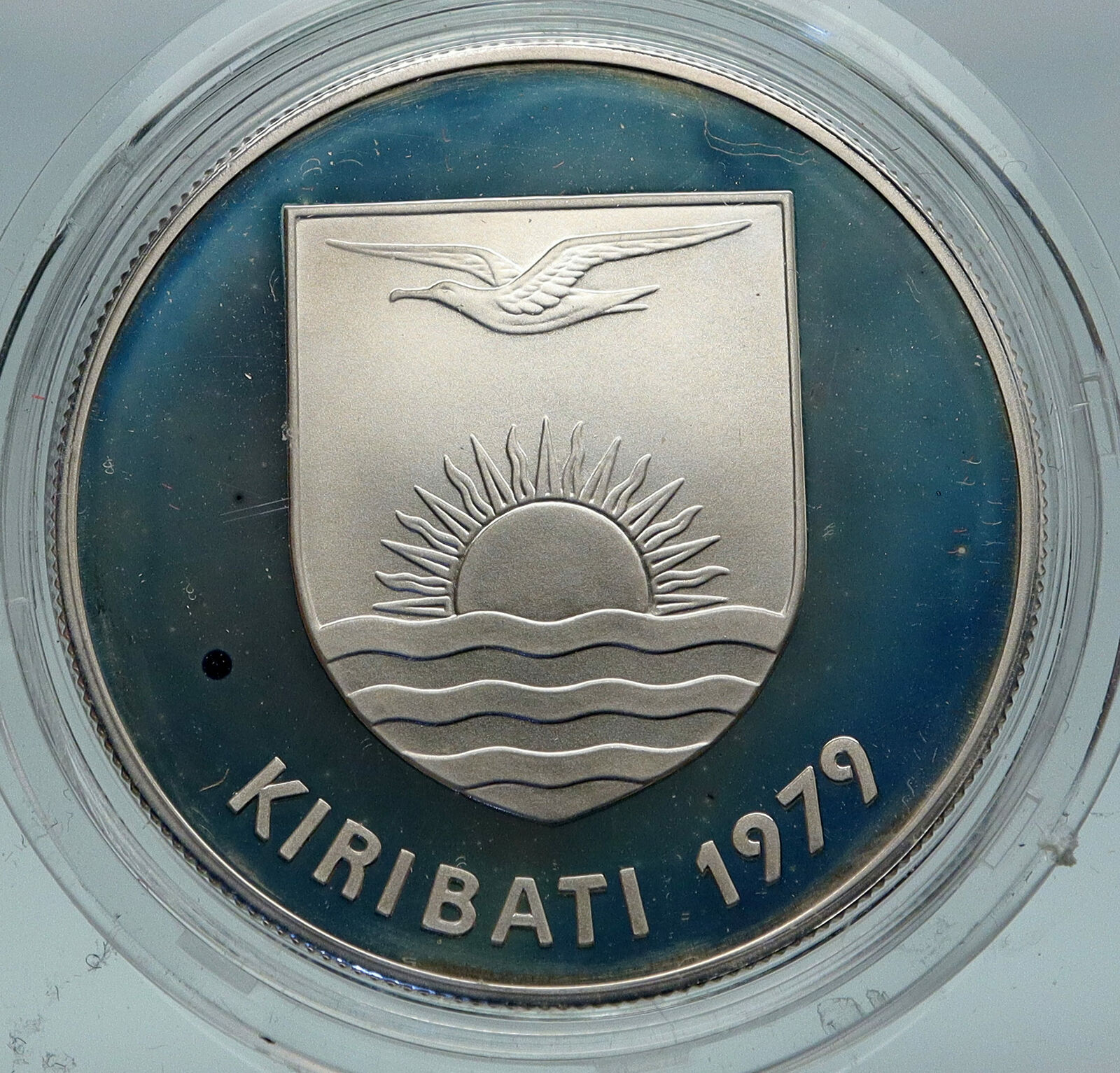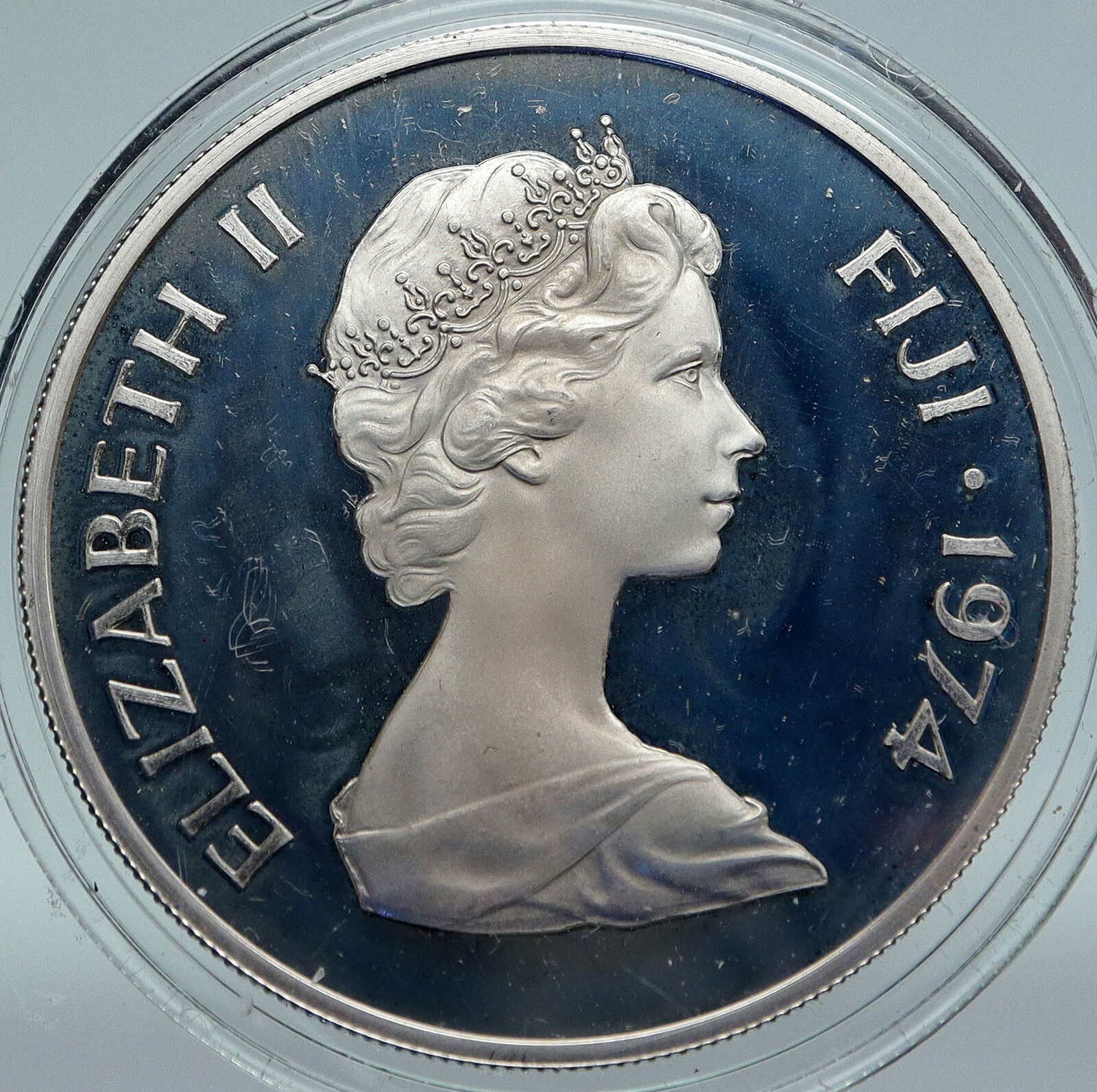|
Samoa
America’s Cup Race – 1987 Perth
1987 Proof 10 Tala 38mm (31.103 grams) .999 Silver (1.00 ASW)
Reference: KM# 66
SAMOA I SISIFO ONE OUNCE · $10 · .999 SILVER, The Cup inside beaded circle above value.
AMERICA’S CUP 1987 PERTH, Sailing scene.
You are bidding on the exact item pictured, provided with a Certificate of Authenticity and Lifetime Guarantee of Authenticity.
 The America’s Cup, informally known as the Auld Mug, is a trophy awarded in the sport of sailing. It is the oldest international competition still operating in any sport.America’s Cup match races are held between two sailing yachts: one from the yacht club that currently holds the trophy (known as the defender) and the other from the yacht club that is challenging for the cup (the challenger). There is no fixed schedule, with matches held several years apart on dates agreed between the defender and the challenger. The most recent America’s Cup match took place in March 2021. The America’s Cup, informally known as the Auld Mug, is a trophy awarded in the sport of sailing. It is the oldest international competition still operating in any sport.America’s Cup match races are held between two sailing yachts: one from the yacht club that currently holds the trophy (known as the defender) and the other from the yacht club that is challenging for the cup (the challenger). There is no fixed schedule, with matches held several years apart on dates agreed between the defender and the challenger. The most recent America’s Cup match took place in March 2021.
The cup was originally known as the ‘R.Y.S. £100 Cup’, awarded in 1851 by the British Royal Yacht Squadron for a race around the Isle of Wight in the United Kingdom. The winning yacht was a schooner called America, owned by a syndicate of members from the New York Yacht Club (NYYC). In 1857, the syndicate permanently donated the trophy to the NYYC, under a Deed of Gift that renamed the trophy as the ‘America’s Cup’ after the first winner and required it be made available for perpetual international competition.
Any yacht club that meets the requirements specified in the deed of gift has the right to challenge the yacht club that currently holds the cup. If the challenging club wins the match, it gains stewardship of the cup. From the first defence of the cup in 1870 until the twentieth defence
in 1967, there was always only one challenger. In 1970 multiple challengers
applied, so a selection series was held to decide which applicant would
become the official challenger and compete in the America’s Cup match. This
approach has been used for each subsequent competition.
The history and prestige associated with the America’s Cup attracts the world’s top sailors, yacht designers, wealthy entrepreneurs and sponsors. It is a test of sailing skill, boat and sail design, and fundraising and management skills. Competing for the cup is expensive, with modern teams spending more than $US100 million each; the 2013 winner was estimated to have spent $US300 million on the competition.
The trophy was held by the NYYC from 1857 until 1983. The NYYC successfully defended the trophy twenty-four times in a row before being defeated by the Royal Perth Yacht Club, represented by the yacht Australia II. Including the original 1851 victory, the NYYC’s 132-year reign was the longest (in terms of time) winning streak in any sport.
Early matches for the cup were raced between yachts 65–90 ft (20–27 m) on the waterline owned by wealthy sportsmen. This culminated with the J-Class regattas of the 1930s. After World War II and almost twenty years without a challenge, the NYYC made changes to the deed of gift to allow smaller, less expensive 12-metre class yachts to compete; this class was used from 1958 until 1987. It was replaced in 1990 by the International America’s Cup Class, which was used until 2007.
The America’s Cup is currently held by the Royal New Zealand Yacht Squadron, who successfully defended the 36th America’s Cup in March 2021 using an AC75 foiling monohull called Te Rehutai, owned and sailed by the Team New Zealand syndicate. The next America’s Cup will be held between the Royal New Zealand Yacht Squadron and the Royal Yacht Squadron, at a date to be determined. Both the 37th and 38th America’s Cup matches will be sailed in AC75 class yachts.
 Samoa (/səˈmoʊə/), officially the Independent State of Samoa (Samoan: Malo Saʻoloto Tutoʻatasi o Sāmoa; Samoan: Sāmoa, IPA: [ˈsaːmoa]) and, until 4 July 1997, known as Western Samoa, is a country consisting of two main islands, Savai’i and Upolu, and four smaller islands. The capital city is Apia. The Lapita people discovered and settled the Samoan Islands around 3,500 years ago. They developed a unique Samoan language and Samoan cultural identity. Samoa (/səˈmoʊə/), officially the Independent State of Samoa (Samoan: Malo Saʻoloto Tutoʻatasi o Sāmoa; Samoan: Sāmoa, IPA: [ˈsaːmoa]) and, until 4 July 1997, known as Western Samoa, is a country consisting of two main islands, Savai’i and Upolu, and four smaller islands. The capital city is Apia. The Lapita people discovered and settled the Samoan Islands around 3,500 years ago. They developed a unique Samoan language and Samoan cultural identity.
Samoa is a unitary parliamentary democracy with eleven administrative divisions. The country is a member of the Commonwealth of Nations. Western Samoa was admitted to the United Nations on 15 December 1976. The entire island group, which includes American Samoa, was called “Navigator Islands” by European explorers before the 20th century because of the Samoans’ seafaring skills.
 .svg/250px-Samoa_on_the_globe_(Polynesia_centered).svg.png) After repeated efforts by the Samoan independence movement, the New Zealand Western Samoa Act 1961 of 24 November 1961 granted Samoa independence, effective on 1 January 1962, upon which the Trusteeship Agreement terminated. Samoa also signed a friendship treaty with New Zealand. Samoa, the first small-island country in the Pacific to become independent, joined the Commonwealth of Nations on 28 August 1970. While independence was achieved at the beginning of January, Samoa annually celebrates 1 June as its independence day. After repeated efforts by the Samoan independence movement, the New Zealand Western Samoa Act 1961 of 24 November 1961 granted Samoa independence, effective on 1 January 1962, upon which the Trusteeship Agreement terminated. Samoa also signed a friendship treaty with New Zealand. Samoa, the first small-island country in the Pacific to become independent, joined the Commonwealth of Nations on 28 August 1970. While independence was achieved at the beginning of January, Samoa annually celebrates 1 June as its independence day.
Travel writer Paul Theroux noted marked differences between the societies in Western Samoa and American Samoa in 1992.
In 2002, New Zealand’s prime minister Helen Clark formally apologised for New Zealand’s role in the events of 1918 and 1929.
Early Samoa
New Zealand scientists have dated remains in Samoa to about 2900 years ago. These were found at a Lapita site at Mulifanua and the findings were published in 1974.
The origins of the Samoans are closely studied in modern research about Polynesia in various scientific disciplines such as genetics, linguistics and anthropology. Scientific research is ongoing, although a number of different theories exist; including one proposing that the Samoans originated from Austronesian predecessors during the terminal eastward Lapita expansion period from Southeast Asia and Melanesia between 2,500 and 1,500 BCE.
Intimate sociocultural and genetic ties were maintained between Samoa, Fiji, and Tonga, and the archaeological record supports oral tradition and native genealogies that indicate inter-island voyaging and intermarriage between pre-colonial Samoans, Fijians, and Tongans. Notable figures in Samoan history included the Tui Manu’a line and Queen Salamasina (15th century). Nafanua was a famous woman warrior who was deified in ancient Samoan religion.
Contact with Europeans began in the early 18th century. Jacob Roggeveen, a Dutchman, was the first known European to sight the Samoan islands in 1722. This visit was followed by French explorer Louis-Antoine de Bougainville, who named them the Navigator Islands in 1768. Contact was limited before the 1830s, which is when English missionaries and traders began arriving.
|




 The America’s Cup, informally known as the Auld Mug, is a trophy awarded in the sport of sailing. It is the oldest international competition still operating in any sport.America’s Cup match races are held between two sailing yachts: one from the yacht club that currently holds the trophy (known as the defender) and the other from the yacht club that is challenging for the cup (the challenger). There is no fixed schedule, with matches held several years apart on dates agreed between the defender and the challenger. The most recent America’s Cup match took place in March 2021.
The America’s Cup, informally known as the Auld Mug, is a trophy awarded in the sport of sailing. It is the oldest international competition still operating in any sport.America’s Cup match races are held between two sailing yachts: one from the yacht club that currently holds the trophy (known as the defender) and the other from the yacht club that is challenging for the cup (the challenger). There is no fixed schedule, with matches held several years apart on dates agreed between the defender and the challenger. The most recent America’s Cup match took place in March 2021. Samoa (/səˈmoʊə/), officially the Independent State of Samoa (Samoan: Malo Saʻoloto Tutoʻatasi o Sāmoa; Samoan: Sāmoa, IPA: [ˈsaːmoa]) and, until 4 July 1997, known as Western Samoa, is a country consisting of two main islands, Savai’i and Upolu, and four smaller islands. The capital city is Apia. The Lapita people discovered and settled the Samoan Islands around 3,500 years ago. They developed a unique Samoan language and Samoan cultural identity.
Samoa (/səˈmoʊə/), officially the Independent State of Samoa (Samoan: Malo Saʻoloto Tutoʻatasi o Sāmoa; Samoan: Sāmoa, IPA: [ˈsaːmoa]) and, until 4 July 1997, known as Western Samoa, is a country consisting of two main islands, Savai’i and Upolu, and four smaller islands. The capital city is Apia. The Lapita people discovered and settled the Samoan Islands around 3,500 years ago. They developed a unique Samoan language and Samoan cultural identity. 
.svg/250px-Samoa_on_the_globe_(Polynesia_centered).svg.png) After repeated efforts by the Samoan independence movement, the New Zealand Western Samoa Act 1961 of 24 November 1961 granted Samoa independence, effective on 1 January 1962, upon which the Trusteeship Agreement terminated. Samoa also signed a friendship treaty with New Zealand. Samoa, the first small-island country in the Pacific to become independent, joined the Commonwealth of Nations on 28 August 1970. While independence was achieved at the beginning of January, Samoa annually celebrates 1 June as its independence day.
After repeated efforts by the Samoan independence movement, the New Zealand Western Samoa Act 1961 of 24 November 1961 granted Samoa independence, effective on 1 January 1962, upon which the Trusteeship Agreement terminated. Samoa also signed a friendship treaty with New Zealand. Samoa, the first small-island country in the Pacific to become independent, joined the Commonwealth of Nations on 28 August 1970. While independence was achieved at the beginning of January, Samoa annually celebrates 1 June as its independence day.




